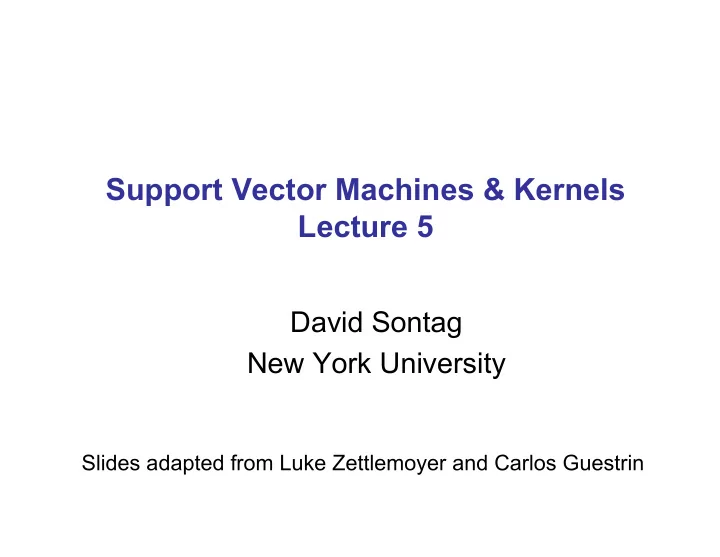

Support Vector Machines & Kernels Lecture 5 David Sontag New York University Slides adapted from Luke Zettlemoyer and Carlos Guestrin
Support Vector Machines QP form: More “natural” form: Equivalent if Regularization Empirical loss term
Subgradient method
Subgradient method Step size:
Stochastic subgradient 1 Subgradient
PEGASOS A_t = S |A_t| = 1 Subgradient method Stochastic gradient 1 Subgradient Projection
Run-Time of Pegasos • Choosing |A t |=1 Run-time required for Pegasos to find ε accurate solution w.p. ¸ 1- δ n = # of features • Run-time does not depend on #examples • Depends on “difficulty” of problem ( λ and ε )
Experiments • 3 datasets (provided by Joachims) – Reuters CCAT (800K examples, 47k features) – Physics ArXiv (62k examples, 100k features) – Covertype (581k examples, 54 features) Pegasos SVM-Perf SVM-Light 2 77 20,075 Reuters Training Time (in seconds): 6 85 25,514 Covertype 2 5 80 Astro-Physics
What’s Next! • Learn one of the most interesting and exciting recent advancements in machine learning – The “kernel trick” – High dimensional feature spaces at no extra cost • But first, a detour – Constrained optimization!
Constrained optimization x ≥ -1 No Constraint x ≥ 1 x*=0 x*=0 x*=1 How do we solve with constraints? Lagrange Multipliers!!!
Lagrange multipliers – Dual variables Add Lagrange multiplier Rewrite Constraint Introduce Lagrangian (objective): We will solve: Why is this equivalent? • min is fighting max! x<b (x-b)<0 max α - α (x-b) = ∞ • min won’t let this happen! Add new constraint x>b, α ≥ 0 (x-b)>0 max α - α (x-b) = 0, α *=0 • min is cool with 0, and L(x, α )=x 2 (original objective) x=b α can be anything, and L(x, α )=x 2 (original objective) The min on the outside forces max to behave, so constraints will be satisfied.
Dual SVM derivation (1) – the linearly separable case (hard margin SVM) Original optimization problem: One Lagrange multiplier Rewrite per example constraints Lagrangian: Our goal now is to solve:
Dual SVM derivation (2) – the linearly separable case (hard margin SVM) (Primal) Swap min and max (Dual) Slater’s condition from convex optimization guarantees that these two optimization problems are equivalent!
Dual SVM derivation (3) – the linearly separable case (hard margin SVM) (Dual) ⇤ ⌅ Can solve for optimal w , b as function of α : ∂ L ⌥ ∂ w = w − α j y j x j j Substituting these values back in (and simplifying), we obtain: (Dual) Sums over all training examples scalars dot product
Reminder: What if the data is not linearly separable? Use features of features of features of features…. x (1) . . . x ( n ) x (1) x (2) φ ( x ) = x (1) x (3) . . . e x (1) . . . Feature space can get really large really quickly!
Higher order polynomials number of monomial terms d=4 m – input features d – degree of polynomial d=3 grows fast! d = 6, m = 100 d=2 about 1.6 billion terms number of input dimensions
Dual formulation only depends on dot-products of the features! First, we introduce a feature mapping : Next, replace the dot product with an equivalent kernel function:
Polynomial kernel d =1 � u 1 � v 1 � ⇥ ⇥ � ⇥ ⇥ φ ( u ) . φ ( v ) = = u 1 v 1 + u 2 v 2 = u.v . u 2 v 2 u 2 v 2 ⇤ ⌅ ⇤ ⌅ d =2 ⌃ ⇧ ⌃ 1 1 u 1 u 2 v 1 v 2 ⌃ = u 2 1 v 2 1 + 2 u 1 v 1 u 2 v 2 + u 2 2 v 2 ⌥ � ⌥ � φ ( u ) . φ ( v ) = ⌃ . ⌥ � ⌥ � 2 u 2 u 1 v 2 v 1 ⇧ ⇧ = ( u 1 v 1 + u 2 v 2 ) 2 u 2 v 2 2 2 = ( u.v ) 2 For any d (we will skip proof): φ ( u ) . φ ( v ) = ( u.v ) d Polynomials of degree exactly d
Common kernels • Polynomials of degree exactly d • Polynomials of degree up to d • Gaussian kernels • Sigmoid • And many others: very active area of research!
Recommend
More recommend